Thanks! And I already expected the copy right issues, although I doubt that the German magazine would object. I can understand a big international forum as this can't allow such things, on the other hand I feel it is a big limitation to the users over here...
I can offer to email the documentation to anyone who might be interested.
I can offer to email the documentation to anyone who might be interested.
I emailed Fountek to see if the would tell me the component values used in the K3. Never got a response. They did publish the values used for the FR135-ex.
http://www.madisound.com/pdf/FR135EX-Encl.pdf
I'm working on my own filter. I don't like the sound of this driver without a filter...and a sub.
I'll soon know exactly what's been done in the K3, either I or my supplier is gonna buy these and figure out the filter they used. If that does not infringe on any copyrighting issues I can post a sketch of the schematic here later on.....
I'll soon know exactly what's been done in the K3, either I or my supplier is gonna buy these and figure out the filter they used. If that does not infringe on any copyrighting issues I can post a sketch of the schematic here later on.....
I'm currently using a single notch 5.6mH/4.7uF/10.0R in a K3 type cabinet (FR89ex). Sounds pretty good even without the sub turned on. I'm going to experiment with a second notch on the highend centered around 12kHz. Funny that my circuit values came in almost exactly like Cardoso's posted earlier.
I'd still like to find out what Fountek is using so I could try...hope you figure it out.
Are you serious?? 12K?? I don't really experience any raised response there...
Once you use the one notch which is around 3kHz, you end up with a rising response that starts around 8kHz and continues on up to around 25kHz.
I would post the graphs but I use calsod for simulation, a DOS program, and I don't know how to get the graphs onto a modern computer.
Okay, the notch does look a bit radical indeed (nothing wrong with that though if it works it works) What about that 25K part, surely only your dog would complain?? My hearing ends at 18K, not bad I guess being almost 40.
In regard to K3 filter, I would guess that it does not correspond to a series of two parallel notch filter, but parallel notch filter in parallel with a series notch filter. I tried this on my early version of FR89 box (now is a 2 way loudspeaker). I didn’t fully work this concept but the results were promising since I realised that with a single notch filter I would never get a fairly raising flat response.
Bellow I present the single notch filter I implemented with better results (to my ears).
Measured unfiltered FR89EX in the box
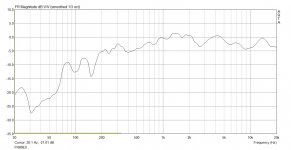
Single notch filter
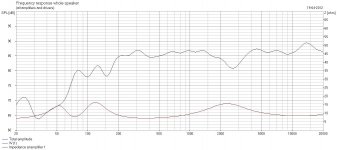
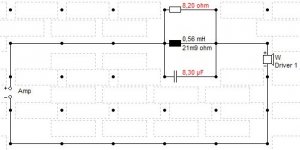
Parallel notch filter in parallel with a series notch filter
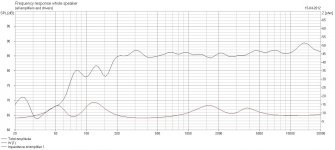
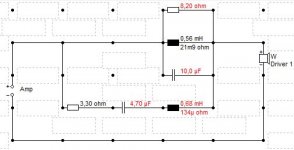
As I previously said, I didn’t fully worked this last version.... so just keep the idea 😉
Bellow I present the single notch filter I implemented with better results (to my ears).
Measured unfiltered FR89EX in the box

Single notch filter


Parallel notch filter in parallel with a series notch filter


As I previously said, I didn’t fully worked this last version.... so just keep the idea 😉
My unfiltered in box measurments differ from Cardoso's. Mine have a more pronounced rising response. I'm currently using Omnimic but I also have a calibrated Earthworks. I'm going to remeasure when I get a chance. I can hear this rise though (48 years old). I use a DEQ to help guide me when I develop crossovers, or in this case passive EQ so I can dial in what ever I want.
I guess I was thinking Fountek used a double notch on the K3 because thats what they used on the T5. So that's what I was trying. Cardoso's series/parallel didn't sim all to well with my measurments but we'll see when I remeasure. I'll have a listen to it either way. I've got the parts. I think I've listened to every circuit that's been posted here on diyaudio at this point.
I would say I like my little FR89ex ,2l/BR with EQ, better then my alpair 10.2 in a MLTL. Excepting of the bass of course.
I guess I was thinking Fountek used a double notch on the K3 because thats what they used on the T5. So that's what I was trying. Cardoso's series/parallel didn't sim all to well with my measurments but we'll see when I remeasure. I'll have a listen to it either way. I've got the parts. I think I've listened to every circuit that's been posted here on diyaudio at this point.
I would say I like my little FR89ex ,2l/BR with EQ, better then my alpair 10.2 in a MLTL. Excepting of the bass of course.
Sounds like they need a parallel LR, not notches. Those are wide bandwidth notches that appear to deal with baffle step rather than response anomaly.
I would agree, though mine definitely don't seem to suffer from this rise, the highs are rather too dull than too bright. Maybe the variations in these drivers from specimen to specimen are pretty great, or we all use a very different enclosure. I know these little ones are very picky when it comes down to baffle size...
The measured response I posted above (unfiltered FR89EX without tweeter)
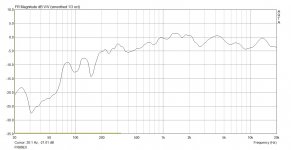
corresponds to this enclosure (22.2cm high x 14,4cm wide baffle).
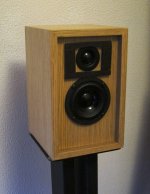
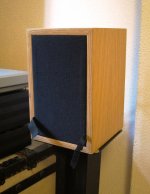
The wide baffle compared to the driver diameter leads to the pronounced mids in the frequency response (definitely not a good baffle design 🙁 ).
I think that with a narrower baffle you will get better response. That’s what probably happens with v-bro’s and grymtr’s designs.

corresponds to this enclosure (22.2cm high x 14,4cm wide baffle).


The wide baffle compared to the driver diameter leads to the pronounced mids in the frequency response (definitely not a good baffle design 🙁 ).
I think that with a narrower baffle you will get better response. That’s what probably happens with v-bro’s and grymtr’s designs.
Last edited:
Yikes, yes, the little edge there all around doesn't quite help either, I've measured what happens when such an edge is applied to my metal enclosure and it wasn't pretty. It wasn't sounding pretty either...
Here are the measurements I once did on a similar active speaker with SPH-30X from Monacor.
41Hz Audio - Megamini the active little beast
No filtering, no grille:
Then with the grille, still no filtering:
Then still with grille and a beta version filter:
Grille removed:
Then I made a different kind of grille, but nowadays I just use fan grilles for computers...
The filter I simulated in LT spice for the SPH-30X
And the final result:
They sound fairly good, but definitely are on the aggressive side still in the mid-high range, probably due to resonances in the cone.
41Hz Audio - Megamini the active little beast
An externally hosted image should be here but it was not working when we last tested it.
No filtering, no grille:
An externally hosted image should be here but it was not working when we last tested it.
Then with the grille, still no filtering:
An externally hosted image should be here but it was not working when we last tested it.
Then still with grille and a beta version filter:
An externally hosted image should be here but it was not working when we last tested it.
Grille removed:
An externally hosted image should be here but it was not working when we last tested it.
Then I made a different kind of grille, but nowadays I just use fan grilles for computers...
The filter I simulated in LT spice for the SPH-30X
An externally hosted image should be here but it was not working when we last tested it.
And the final result:
An externally hosted image should be here but it was not working when we last tested it.
An externally hosted image should be here but it was not working when we last tested it.
They sound fairly good, but definitely are on the aggressive side still in the mid-high range, probably due to resonances in the cone.
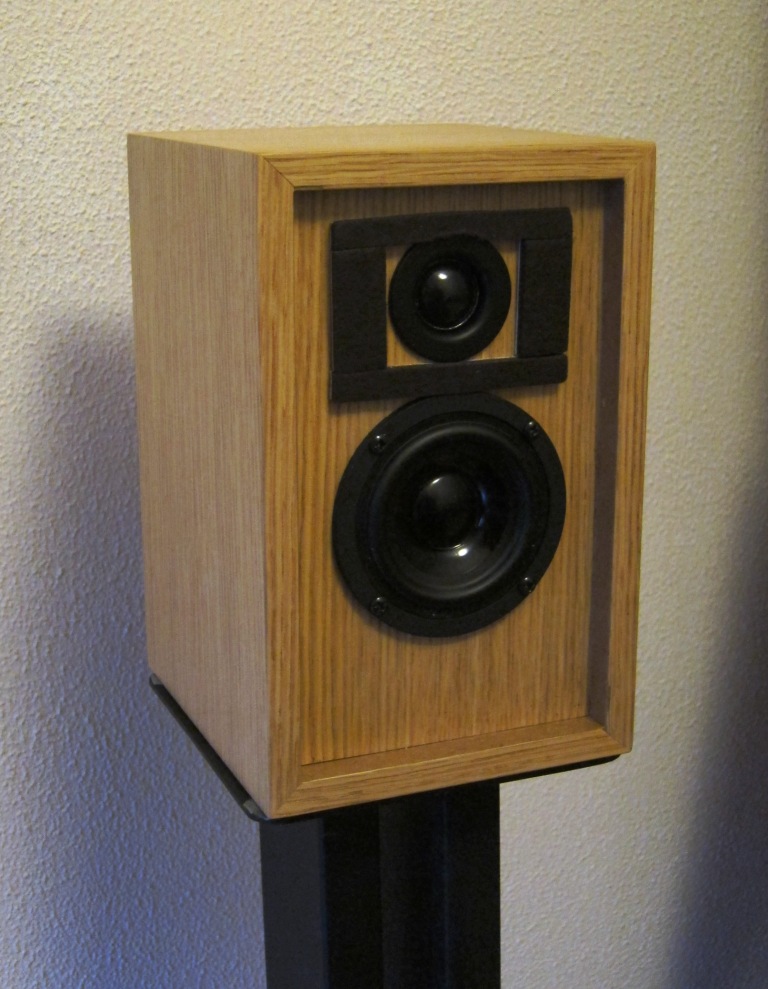
You know Esaú, the fact that the driver is almost in the middle of the box, and the edges on it all make the baffle step effects the worst of the worst. You seem like you know your stuff, how on earth could you build it so bad??😕
hehe that's not baffle step, it's baffle diffraction! 😀
Baffle step is a diffraction effect just the same, the shape of a baffle just determines in what kind of way it will display itself. Ideally just a little ripple, but when the edges are made differently (sphere, cube etc.) it will have a different pattern, eventually making it impossible to handle it with a simple filter.
Baffle Diffraction Step
http://www.linkwitzlab.com/diffraction.htm
Last edited:
I suspect Esaú was inspired by the LS3/5A design. Reminds me of it instantly.
Maybe placing some foam and felt around the inner side of the grill frame may help the problem a little bit.
Maybe placing some foam and felt around the inner side of the grill frame may help the problem a little bit.
I suspect Esaú was inspired by the LS3/5A design. Reminds me of it instantly.
Maybe placing some foam and felt around the inner side of the grill frame may help the problem a little bit.
From what I understood the tweeter was implemented later on, so the similarity with the Kef LS3/5A must have arised after that. Or he maybe built the boxes after discovering it needed a tweet, don't know.
I don't really feel like mine need a tweet by the way, they may be a bit mellow in the high range, but it is definitely there, even under an angle. I prefer this much over the aggressive high range of many other fullrangers (like the SPH-30X) and even some tweeters....
Been listening to the FR89EX pair a few days now and they are really starting to grow on me. Usually the sound that is spectacular the first minute starts to irritate after a while. This pair seemed a bit shy at the start, but now I find them just so subtle and smooth, they just thrill me more and more.
I want to make some designs in wood as well, over at where I work there is a CNC wood milling/routing machine. My colleagues over there can cut me the panels for a crate of beer. 🙂
I want to make some designs in wood as well, over at where I work there is a CNC wood milling/routing machine. My colleagues over there can cut me the panels for a crate of beer. 🙂
Yes. I admit that LS3/5 was an inspiration to this design.
I did try a 1cm thick foam all around the tweeter and the fullrange but the differences was only minor. Actually I thought from the beginning that filling the front baffle with this foam would solve almost completely the bad baffle shape….. Wrong!
Frequency response with 1cm foam
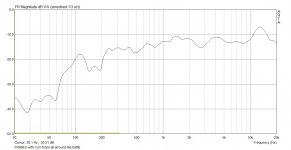
As to the tweeter, I keep from the beginning the possibility of using a tweeter.. just in case. I’m still working on it…
Nevertheless, I sure did learn from my mistakes….
Any way, considering all this problems with the baffle, I always felt that FR89EX was a very good fullrange with very soft and precise response…. but with a narrow well designed baffle.
I did try a 1cm thick foam all around the tweeter and the fullrange but the differences was only minor. Actually I thought from the beginning that filling the front baffle with this foam would solve almost completely the bad baffle shape….. Wrong!

Frequency response with 1cm foam

As to the tweeter, I keep from the beginning the possibility of using a tweeter.. just in case. I’m still working on it…
Nevertheless, I sure did learn from my mistakes….

Any way, considering all this problems with the baffle, I always felt that FR89EX was a very good fullrange with very soft and precise response…. but with a narrow well designed baffle.
- Status
- Not open for further replies.
- Home
- Loudspeakers
- Full Range
- Fountek FR88-EX